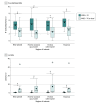Assessment of Brain Magnetic Resonance and Spectroscopy Imaging Findings and Outcomes After Pediatric Cardiac Arrest
- PMID: 37389874
- PMCID: PMC10314315
- DOI: 10.1001/jamanetworkopen.2023.20713
Assessment of Brain Magnetic Resonance and Spectroscopy Imaging Findings and Outcomes After Pediatric Cardiac Arrest
Abstract
Importance: Morbidity and mortality after pediatric cardiac arrest are chiefly due to hypoxic-ischemic brain injury. Brain features seen on magnetic resonance imaging (MRI) and magnetic resonance spectroscopy (MRS) after arrest may identify injury and aid in outcome assessments.
Objective: To analyze the association of brain lesions seen on T2-weighted MRI and diffusion-weighted imaging and N-acetylaspartate (NAA) and lactate concentrations seen on MRS with 1-year outcomes after pediatric cardiac arrest.
Design, setting, and participants: This multicenter cohort study took place in pediatric intensive care units at 14 US hospitals between May 16, 2017, and August 19, 2020. Children aged 48 hours to 17 years who were resuscitated from in-hospital or out-of-hospital cardiac arrest and who had a clinical brain MRI or MRS performed within 14 days postarrest were included in the study. Data were analyzed from January 2022 to February 2023.
Exposure: Brain MRI or MRS.
Main outcomes and measures: The primary outcome was an unfavorable outcome (either death or survival with a Vineland Adaptive Behavior Scales, Third Edition, score of <70) at 1 year after cardiac arrest. MRI brain lesions were scored according to region and severity (0 = none, 1 = mild, 2 = moderate, 3 = severe) by 2 blinded pediatric neuroradiologists. MRI Injury Score was a sum of T2-weighted and diffusion-weighted imaging lesions in gray and white matter (maximum score, 34). MRS lactate and NAA concentrations in the basal ganglia, thalamus, and occipital-parietal white and gray matter were quantified. Logistic regression was performed to determine the association of MRI and MRS features with patient outcomes.
Results: A total of 98 children, including 66 children who underwent brain MRI (median [IQR] age, 1.0 [0.0-3.0] years; 28 girls [42.4%]; 46 White children [69.7%]) and 32 children who underwent brain MRS (median [IQR] age, 1.0 [0.0-9.5] years; 13 girls [40.6%]; 21 White children [65.6%]) were included in the study. In the MRI group, 23 children (34.8%) had an unfavorable outcome, and in the MRS group, 12 children (37.5%) had an unfavorable outcome. MRI Injury Scores were higher among children with an unfavorable outcome (median [IQR] score, 22 [7-32]) than children with a favorable outcome (median [IQR] score, 1 [0-8]). Increased lactate and decreased NAA in all 4 regions of interest were associated with an unfavorable outcome. In a multivariable logistic regression adjusted for clinical characteristics, increased MRI Injury Score (odds ratio, 1.12; 95% CI, 1.04-1.20) was associated with an unfavorable outcome.
Conclusions and relevance: In this cohort study of children with cardiac arrest, brain features seen on MRI and MRS performed within 2 weeks after arrest were associated with 1-year outcomes, suggesting the utility of these imaging modalities to identify injury and assess outcomes.
Conflict of interest statement
Figures

References
-
- Fink EL, Manole MD, Clark RSB. Rogers Textbook of Pediatric Intensive Care. 4th ed. Lippincott Williams & Williams; 2015.
-
- Geocadin RG, Callaway CW, Fink EL, et al. ; American Heart Association Emergency Cardiovascular Care Committee . Standards for studies of neurological prognostication in comatose survivors of cardiac arrest: a scientific statement from the American Heart Association. Circulation. 2019;140(9):e517-e542. doi:10.1161/CIR.0000000000000702 - DOI - PubMed
-
- Scholefield BR, Tijssen J, Ganesan SL, et al. . Brain imaging for the prediction of survival with good neurological outcome after return of circulation following pediatric cardiac arrest: consensus on science with treatment recommendations. International Liaison Committee on Resuscitation. December 18, 2022. Updated January 9, 2023. Accessed May 16, 2023. https://costr.ilcor.org/document/brain-imaging-for-the-prediction-of-sur...
Publication types
MeSH terms
Grants and funding
LinkOut - more resources
Full Text Sources
Medical

